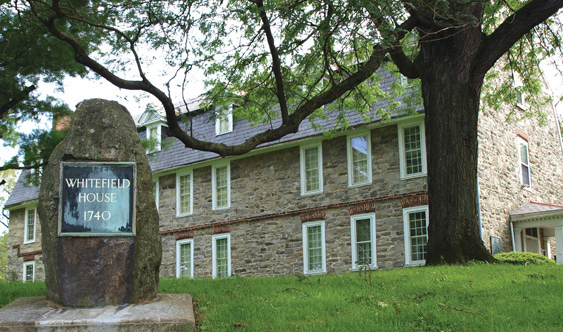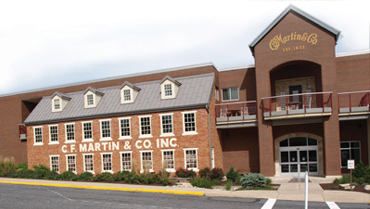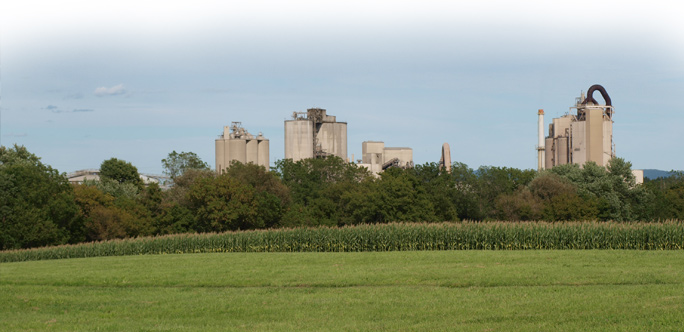Nazareth
The Borough of Nazareth is a vibrant and picturesque small community that is home to just over 6,000 residents. Set against the idyllic countryside a few miles north of Bethlehem, it boasts a rich history that dates back to the colonial era and has played an integral role in the religious, economic, social, academic, and architectural development of the Lehigh Valley. The area began as a small Moravian community that gradually grew into a prospering farming community, educational center, and domestic cement manufacturing base over the course of the last 250 years. Today Nazareth, with its historical district on the National Register of Historic Places, is a diverse area with a thriving economy, quality education system, and growing residential appeal.
Nazareth began to take shape in 1740 when George Whitefield, a widely recognized travelling preacher and close friend of Benjamin Franklin, purchased a 5,000 acre parcel of land originally owned by the William Penn family. Stretching across parts of the present day Boroughs of Nazareth, Tatamy, and Stockertown, as well as the Townships of Lower Nazareth, Upper Nazareth, and Bushkill, the land was intended to be used for a school for orphaned African American children and a haven for English immigrants. Whitefield hired a small group of Moravians who had left the colony of Georgia because of conflict over their pacifist beliefs to help with the building of the new community. The area was called the Barony of Nazareth, but was better known as the Barony of the Rose as the annual property tax was just one rose.
 The Moravians began their work on constructing log cabins and a main community building, and in 1741 were able to purchase the entire Barony due to Whitefield’s financial difficulties. Despite conflicts with the local Lenape tribe, the Moravians continued their development with assistance from Count Zinzendorf, cofounder of the nearby Bethlehem Moravian community. In 1743, 33 young Moravian couples arrived from Europe and settled into communal living at the Whitefield House. The community rapidly grew to prosperity under a “general economy” model in which economic resources were pooled for the benefit of the congregation and the church owned all land. The downtown area was established with streets in the shape of a cross, and new sawmills, gristmills, and local stores were opened. Nazareth Hall, built in 1754, housed a prestigious boys’ academy and led to the founding of Moravian College and Theological Seminary in 1807. The academic institution, one of the oldest in the country, was situated in Nazareth until its relocation to Bethlehem in 1858.
The Moravians began their work on constructing log cabins and a main community building, and in 1741 were able to purchase the entire Barony due to Whitefield’s financial difficulties. Despite conflicts with the local Lenape tribe, the Moravians continued their development with assistance from Count Zinzendorf, cofounder of the nearby Bethlehem Moravian community. In 1743, 33 young Moravian couples arrived from Europe and settled into communal living at the Whitefield House. The community rapidly grew to prosperity under a “general economy” model in which economic resources were pooled for the benefit of the congregation and the church owned all land. The downtown area was established with streets in the shape of a cross, and new sawmills, gristmills, and local stores were opened. Nazareth Hall, built in 1754, housed a prestigious boys’ academy and led to the founding of Moravian College and Theological Seminary in 1807. The academic institution, one of the oldest in the country, was situated in Nazareth until its relocation to Bethlehem in 1858.
1858 served as a turning point for the area’s growth as the community was opened to non-Moravian settlers. Over the next 25 years, the population grew from 400 to 1,000 residents, and by 1900 the community was home to over 2,400 residents of varying ethnic and religious backgrounds. It was during this period that Nazareth experienced rapid industrial growth. Some of the early manufacturing industries included textiles and carriages, as well as C.F. Martin & Co.’s guitar production. Additional growth was sparked by the arrival of cement manufacturing in the late 1800s. The Nazareth Cement Company opened its first plant just outside the Borough in 1898 and was followed by the Hercules and Penn-Dixie cement plants in the early 20th century. By 1938, Nazareth had become the leading commercial center of Northampton County.
Today, Nazareth remains a bustling small town with a vibrant economy that has survived the downturn of local cement manufacturing. Of the many cement companies, ESSROC (formerly Coplay Cement) has remained in the area with its headquarters located in Nazareth. Additional local industries that continue to thrive include textiles, chemicals, and plastics manufacturers. The area is also home to a wealth of locally owned businesses and community organizations that have strengthened its modern economic and residential appeal while preserving its rich history and legacy.
SEE & DO
 Founded in 1833, C.F. Martin & Co. is the oldest producer of guitars and the largest domestic manufacturer of acoustic guitars. Originally headquartered in Manhattan’s Lower East Side, the company moved to Nazareth when founder Christian Frederick Martin’s wife fell in love with the bucolic setting during a visit to a business associate’s home. Over the past 175 years, the company has grown from a small regional manufacturer and retailer that traded its quality guitars for clothing and crates of wine to an internationally recognized leader known for its unwavering commitment to quality. In fact, the list of Martin guitar players reads as a veritable pantheon of musical genius including such names as Elvis Presley, Paul McCartney, Johnny Cash, Bob Dylan, Joni Mitchell, and Jimi Hendrix. In recent years, the company has embraced new designs and technology and celebrated the production of its millionth guitar, a testament to the skill of expert craftsmen and the vision of the Martin family. The public can experience the magic and history of these exquisite instruments by visiting the Martin Guitar Museum; exploring the Guitarmaker’s Connection, a retail store housed in the original factory and Martin homestead; and attending a guided factory tour held at regular intervals from 11am to 2:30pm during the week. Visitors can also purchase souvenirs at the 1833 Shop and play limited edition and high-end guitars at the Pickin’ Parlor. 510 Sycamore Street, 610.759.2837, martinguitar.com.
Founded in 1833, C.F. Martin & Co. is the oldest producer of guitars and the largest domestic manufacturer of acoustic guitars. Originally headquartered in Manhattan’s Lower East Side, the company moved to Nazareth when founder Christian Frederick Martin’s wife fell in love with the bucolic setting during a visit to a business associate’s home. Over the past 175 years, the company has grown from a small regional manufacturer and retailer that traded its quality guitars for clothing and crates of wine to an internationally recognized leader known for its unwavering commitment to quality. In fact, the list of Martin guitar players reads as a veritable pantheon of musical genius including such names as Elvis Presley, Paul McCartney, Johnny Cash, Bob Dylan, Joni Mitchell, and Jimi Hendrix. In recent years, the company has embraced new designs and technology and celebrated the production of its millionth guitar, a testament to the skill of expert craftsmen and the vision of the Martin family. The public can experience the magic and history of these exquisite instruments by visiting the Martin Guitar Museum; exploring the Guitarmaker’s Connection, a retail store housed in the original factory and Martin homestead; and attending a guided factory tour held at regular intervals from 11am to 2:30pm during the week. Visitors can also purchase souvenirs at the 1833 Shop and play limited edition and high-end guitars at the Pickin’ Parlor. 510 Sycamore Street, 610.759.2837, martinguitar.com.
The Whitefield House, originally called the “stone house”, opened its doors in 1743 as the communal home for 33 couples of Moravian newlyweds arriving in the area to establish the faith-based community of Nazareth. While the purpose of the building evolved over time, it always played a pivotal role in the community including worship center, children’s nursery, and communal residence for children. In the early 19th century, the house served as the primary location for Moravian College and Theological Seminary. When the academic institution relocated to nearby Bethlehem in 1858, the building was converted back to apartments including one that served as the offices for the Moravian Historical Society. The building was officially handed over to the Society in 1978 and today is home to a vibrant museum featuring permanent and traveling exhibits highlighting the historical, cultural, religious, political, and academic influence of the Moravian community. The museum is open to the public seven days a week from 1 to 4pm. 214 East Center Street, 610.759.5070, moravianhistoricalsociety.com.
EAT & DRINK
At Beck’s Land and Sea House, husband and wife team Randy and Cheryl Beck offer classic steak and seafood fare with an emphasis on local, seasonal ingredients. Guests can enjoy traditional favorites such as South Africa twin lobster tails and Alaskan king crab legs, as well as more inventive dishes including a delicately layered crab imperial and fried eggplant napoleon and a chili-crusted tuna served with sesame noodles and a fragrant ginger dipping sauce. The diverse menu also features a wide array of steaks and signature entrées accompanied by a well-rounded wine list.997 Bushkill Center Road, 610.746.7400, beckslandseahouse.com.
Built in 1750 on land originally owned by William Penn, the Newburg Inn is a historical gem that previously served as a colonial trading post and a stagecoach stop. The rustic and charming setting sprinkled with antique furniture and accessories pays homage to the legacy of the building and the history of the surrounding area. The eclectic menu ranges from country style favorites and American comfort food to Italian pasta classics and Asian-influenced seafood. The lively bar features a fun drink list and hosts a weekly happy hour on Monday evenings. 4357 Newburg Inn, 610.759.8528, newburginn.com.
Rios Brazilian Steakhouse offers traditional southern Brazilian cuisine served in the rodizio de churrasco style in which guests receive an unlimited meal of various types of meat that are sliced table-side. The meats, which are offered several times throughout the course of the meal, include bacon-wrapped filet mignon, grilled dark-meat chicken, and beef short ribs. These succulent dishes are accompanied by sides that are served family-style such as Spanish fried potatoes, black beans, and rice, as well as grilled fruit meant to serve as a palate cleanser between courses. A chic décor and extensive cocktail menu featuring the classic caipirinha add to this restaurant’s fun and festive appeal. 127 South Broad Street, 610.614.1018, riosbraziliansteakhousepa.com.
SHOP
Since 1965, Bridals by Sandra has been helping brides find the perfect ensemble for that special day. Featuring an extensive bridal gown collection with varying silhouettes and fabrics at affordable price points, the store provides private consultations, custom alterations, and a fire-proof vault for pre-wedding storage. The boutique also offers bridal accessories, bridal party dresses, and tuxedo rentals, as well as dresses for special occasions such as prom and homecoming. 56 East Lawn Road, 610.759.5156, bridalsbysandra.com.
Missing Piece has been helping Lehigh Valley residents find that special something to perfect their home décor and lifestyle. This unique store offers a wide variety of high quality furniture, lighting, window treatments, carpeting, and other home accessories. In addition, the expansive two-story shop also features novel and whimsical gifts and accessories such as Vera Bradley products, Chamilia Beads jewelry, and Lolita stemware. Co-owner Karen Sampson is available for design advice and can also help customers set up personal private shopping nights. 462 Bushkill Center Drive, 610.759.4033, shopmissingpiece.com.





